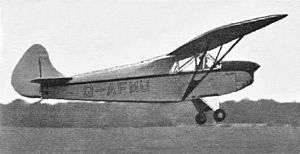Luton Major
| L.A.5 Major | |
|---|---|
 | |
| Luton LA.5 Major, 1939 | |
| Role | Two-seat cabin monoplane |
| Manufacturer | Homebuilt |
| Designer | C.H. Latimer-Needham |
| First flight | 12 March 1939 |
The Luton L.A.5 Major was a 1930s British two-seat high-wing cabin monoplane. Following World War II, plans were made available to suit construction as a homebuilt aircraft.[1]
History
The original L.A.5 Major was a two-seat light aircraft powered by a 62 hp Walter Mikron II engine. It was designed by C.H. Latimer-Needham, and built in 1939 by Luton Aircraft Limited at its Phoenix Works, Gerrards Cross, Buckinghamshire. The prototype (G-AFMU), designated L.A.5 Major, first flew on 12 March 1939. During 1943, the Phoenix Works burnt down, destroying the prototype, and causing the Luton Aircraft company to close.[2]
After World War II, Phoenix Aircraft Limited, formed by the designer C.H. Latimer-Needham and A.W.J.G. Ord-Hume, took over the design rights for the Luton Major. Latimer-Needham updated the design to make it more suitable for homebuilding, in which form it has become L.A.5A Major, with plans marketed by Falconar Avia of Edmonton, Alberta, Canada as the Cubmajor. An open cockpit version is marketed as the Majorette.[2][3][4]
Variants
Specifications (L.A.5)
Data from Sport Aviation
General characteristics
- Crew: 1
- Capacity: 1
- Length: 7.24 m (23 ft 9 in)
- Wingspan: 10.72 m (35 ft 2 in)
- Wing area: 15.1 m2 (163 sq ft)
- Empty weight: 272 kg (600 lb)
- Gross weight: 467 kg (1,030 lb)
- Fuel capacity: 11 imperial gallons
- Powerplant: 1 × Walter Mikron II , 46 kW (62 hp)
- Propellers: 2-bladed
Performance
- Maximum speed: 169 km/h; 91 kn (105 mph)
- Cruise speed: 153 km/h; 83 kn (95 mph)
- Stall speed: 56 km/h; 30 kn (35 mph)
- Range: 483 km; 261 nmi (300 mi)
- Rate of climb: 3.6 m/s (700 ft/min)
Notes
Bibliography
| Wikimedia Commons has media related to Luton Major. |
- Jackson, A.J. (1974). British Civil Aircraft since 1919 Volume 3. Putnam ISBN 0-370-10014-X